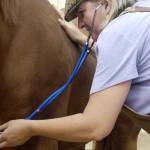Diagnosing Upper Respiratory Problems in Horses

If your sport horse can’t breathe properly, he can’t perform to his maximal ability. A drop in athletic performance, unusually noisy breathing, or an abnormally long period of recovery after exercise are all signs that the horse may have some sort of respiratory problem. Veterinarians use several techniques to examine the upper respiratory tract, find the cause of the problem, and correct it with medication or surgery.
Noisy breathing in particular is a sign of an abnormality somewhere in the upper rather than the lower respiratory tract. Problems in the upper respiratory tract can be mild and easily to correct, or serious enough to end a horse’s active career. Anything that blocks the free flow of air—infection, inflammation, narrowing of air passages, tumors, displaced or scarred tissues—can restrict the horse’s ability to perform and recover quickly from exercise. An examination by a veterinarian is the only way to identify the cause and suggest a cure for the condition.
One of the veterinarian’s first steps in tracking down respiratory trouble is listening to what the owner or trainer has noticed about changes in the horse’s management or performance. He will want to know the horse’s training history, recent decreases in ability to work, and any illnesses or injuries the horse has had. He will also ask about details of the feeding program, whether other horses in the stable are affected with respiratory problems, and whether this horse has previously been examined for similar conditions.
A physical examination is next on the agenda. The veterinarian will begin by looking at and feeling the horse’s head and neck structures including the trachea and jugular veins. He will listen to the heart and lungs and will note any sign of injury, nasal discharge, appearance of the face and eyes, of unusual odor in the horse’s exhaled breath. He may want to watch the horse as it is led or ridden at several gaits, noting head carriage, gait abnormalities, and respiratory sounds.
Based on what he has learned so far, the veterinarian may use continue the diagnostic procedure by using an endoscope to examine the parts of the upper respiratory system that can’t be seen in other ways. He will look for signs of swelling, tumors, narrowed airways, and particular conditions such as epiglottic entrapment or dorsal displacement of the soft palate.
While some of these conditions could be observed in a horse at rest, others are more likely to occur most frequently while the horse is exercising. By examining the horse endoscopically as it is ridden or running on a treadmill, a veterinarian can see changes such as collapse of the pharynx or other structures that happen only when the horse is breathing hard. Developments such as a backpack mounted endoscope worn by a rider can uncover problems that would not be seen in a horse at rest or performing light exercise.
For an examination while the horse is exercising, it’s important to reproduce the conditions in which a respiratory problem has been noticed. The horse should wear its normal saddle and bridle and follow its regular training program during the exam. Though not all upper respiratory abnormalities can be alleviated, the majority can be improved by medication, surgery, or a combination of the two. Other conditions respond to a change in training. For example, some horses have trouble breathing when they are asked to work with an arched neck or in a collected frame. What the rider may see as disobedience or a stubborn attitude might actually be a reluctance by the horse to assume a certain posture because its particular conformation causes airway compression. Still other respiratory conditions such as heaves, an allergic reaction to dust and mold, can be cleared up by management changes like keeping the horse in the pasture rather than in a stall.








